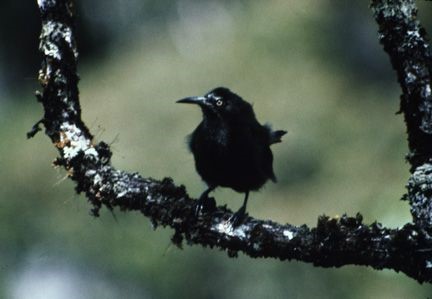Alakai Wilderness, Kauai, Hawaii
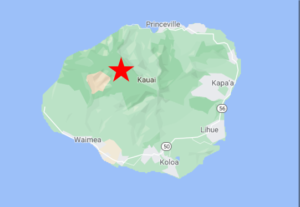
The Alakai Plateau in Kauai’s northwestern highlands is the only place where one could reasonably hope to find three critically endangered species: the Puaiohi, Akikiki, and Akeke’e. Another three Kauai endemics inhabit the Alakai but are not restricted to it: the Kauai Elepaio, Anianiau, and Kauai Amakihi. The Alakai has also become a burial ground, where in the late 1900s five bird species drew their final breaths on Earth: the Kama’o, Kauai O’o, O’u, Kauai Nukupu’u, and Kauai Akialoa.
Orientation
Directions
The Alakai Wilderness Preserve is accessible only on foot, via two trails from Koke’e State Park. One trail is readily accessible to visitors: the Alakai Swamp Trail. The most efficient way to reach it is to drive to the end of Highway 550 to the Pu’u O Kila Overlook and hike the Pihea Trail, which intersects the Alakai Swamp Trail after about two miles.
The other route into the preserve, known as Camp 10 Road, is an alternative route to the Alakai Swamp and Pihea Trails (at their lower trailheads), and ends at the Mohihi-Waiale Trail—a four-mile path across the heart of the Alakai Wilderness. Camp 10 Road is unpaved and only partly drivable in a regular passenger car. It intersects the main park road across from the campground, which is just past the headquarters.
Birdfinding
The Alakai Wilderness Preserve is not an easy place to reach, and any birdwatchers who make the considerable effort entailed will certainly be focused on finding the three hyper-rarities that are effectively confined to it: Puaiohi, Akikiki, and Akeke’e. The latter two have declined precipitously in the 2000s (and could be extinct before you have a chance to visit), while the former has actually increased but is almost never reported. This is not a hopeful scenario for any visiting birdwatcher—going by the numbers, the only “realistic” expectation is failure.
With that caveat in mind, as of 2020, hikers on the Pihea and Alakai Swamp Trails were still occasionally finding Akeke’e, and the Puaiohi is always a remote possibility. Unless there is an unexpected change, Akikiki sightings along the maintained trails seem to have crossed the threshold from remotely possible to merely conceivable.

Puaiohi in the Alakai Wilderness Preserve. © Gavin Emmons
Upper Pihea Trail. For visiting birdwatchers, the most plausible access to the Alakai Wilderness is to hike the Pihea Trail, starting from the Pu’u O Kilo Overlook in Koke’e State Park. The overlook itself is a good place to find Kauai Elepaio and Kauai Amakihi, and could produce I’iwi, Anianiau, or Akeke’e, but the odds of these improve by walking the trail.
The first mile of the Pihea Trail stays on Pihea Ridge between the Kalalau Valley and the Kauaikinana Stream drainage. Then the trail takes a hard right turn and descends to the Alakai Plateau, and about a mile later intersects the Alakai Swamp Trail. For a good chance of seeing all the common species, hike a short distance into this descent and spend some time quietly observing some of the better vantage points into both the canopy and the understorey.

Male Akeke’e at the junction of the Pihea and Alakai Swamp Trails. © Jen Sanford
Until the 2010s the Akeke’e was regular along the upper portion of Pihea Trail (especially along Pihea Ridge), and in prior decades the Akikiki could often be found with a reasonable confluence of effort and luck (especially on the downslope toward the Alakai Swamp). As of 2020, however, the Akikiki is highly unlikely here and the Akeke’e is infrequent and unpredictable.
Weather permitting, most visitors will opt to turn onto the Alakai Swamp Trail, which skirts just inside the lower boundary of the Alakai Wilderness Preserve and after two miles terminates at the spectacular Kilohana Overlook. This hike provides a small chance of finding either of the super-rarities, Puaiohi and Akikiki.

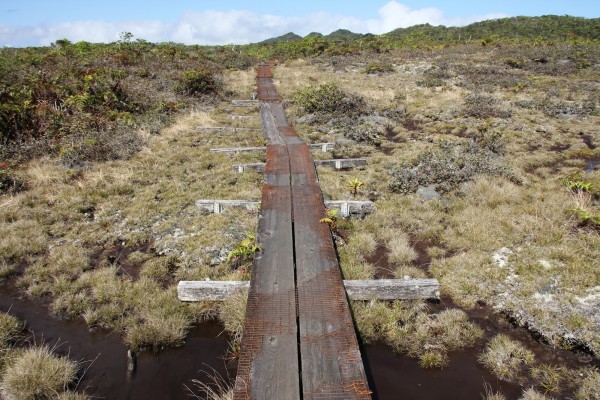
Alakai Swamp Trail bog boardwalk. © Catherine Toth Fox
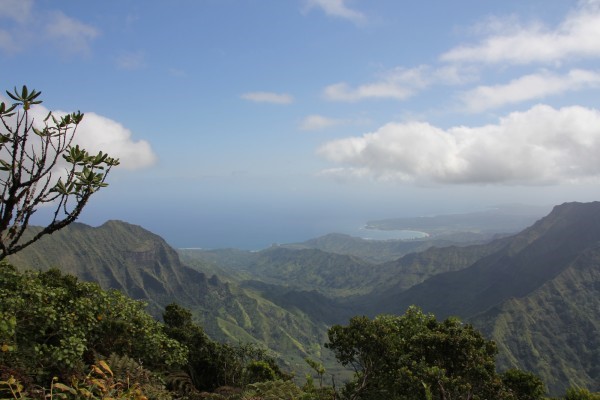
The view toward Hanalei Bay from the Kilohana Overlook, at the end of the Alakai Swamp Trail. © Catherine Toth Fox
Lower Alakai Swamp Trail. It is also possible to begin either the Pihea or Alakai Swamp Trails from their lower trailheads, accessed via Camp 10 Road. From the campground junction on Highway 550, the Berry Flat trailhead is about 1.2 miles. Another 1.5 miles past Berry Flat is the Alakai Picnic Area, where a short side-road leads to the trailhead for the Alakai Swamp Trail (i.e., the lower end of the trail to the Kilohana Overlook, as discussed above).
Lower Pihea Trail. About 0.8 miles past the Alakai Picnic Area, Kawaikoi Stream crosses Camp 10 Road. When the stream is running high, this is effectively the end of the road for most visitors, as the water may be unsafe or too uncomfortable to wade across. On the near side of the stream is Kawaikoi Campground and the lower trailhead for the Pihea Trail—it is about a four-mile hike from here to the Pu’u O Kilo Overlook.
The lower portion of the Pihea Trail passes through some of the best accessible habitat for both Puaiohi and Akikiki.

The Akikiki was formerly fairly common in Koke’e State Park, but is increasingly limited to the inaccessible interior of the Alaka’i Wilderness Preserve. © Bret Mossman
Kawaikoi Trail. On the farther side of the stream is the Sugi Grove picnic area and the Kawaikoi Trailhead. This trail is especially noted for its scenic beauty and for a strong record of producing Akikiki—although those days may be past.
Mohihi-Waiale Trail. Continue 2.5 miles past the Kawaikoi Stream crossing to reach Camp 10, the end of the road and the gateway to the Alakai Wilderness via the Mohihi-Waiale Trail. This trail first descends then crosses the Mohihi Valley, then follows the ridgeline between the Mohihi and Koai’e watersheds. After approximately four miles, the trail reaches the old Koai’e Camp, where it officially ends. Since the 2010s, the Mohihi-Waiale Trail has afforded the best prospects for finding the Puaiohi, Akikiki, and Akeke’e.
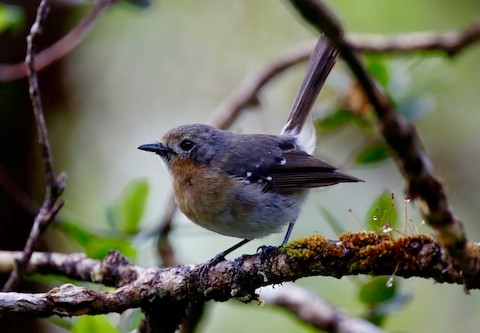
Kauai Elepaio along the Pihea Trail. © Timo Mitzen
Avian Ghosts. During the late 1900s the Alakai Swamp acquired a mythical status, with all six of the now-remaining Kauai endemics plus five more critically endangered bird species—with eleven endemic bird species, it was among the most “biodiverse” patches of real estate in the world.
Those days are past. The Kama’o, Kauai O’o, O’u, Kauai Nukupu’u, and Kauai Akialoa are extinct and will not return unless reanimated through heroic interventions of genetic engineering. Such “Jurassic Park” interventions are increasingly plausible, but the rediscovery of long-lost wild populations is no longer a viable hope. Over decades of fieldwork, it is extremely unlikely that any of these species could have persisted without being noticed.
Services
Accommodations
There are no accommodations in the Aalakai Wilderness. See Koke’e State Park.
Notes
Hazards & Hassles
The Alakai Wilderness is among the most challenging areas to explore, mainly due to weather and the condition of the roads and trails.
The highlands of northwestern Kauai receive about as much annual precipitation as any other place on the planet—in fact, Mount Wai’ale’ale, at the upper end of the Alakai Wilderness, was long regarded as the wettest place on Earth (but has been demoted to second-wettest since being usurped by the rain gauge at Mawsynram in India). Many parts of the Koke’e region are perpetually muddy, and on some trails into the Alakai Swamp the mud is generally advertised as being waist-deep.
It rains most days and is cloudy most of the time. Evenings and mornings are cold, but midday can be hot—and is almost always humid. It is difficult to dress comfortably for these conditions, especially accounting for the exertion of trail exploration.
Camp 10 Road is treacherous and should be driven only to one of the natural stopping points near the Pu’u Ka Ohelo and Berry Flat Trails—except by experienced drivers with vehicles that are suitably rugged for the conditions that prevail beyond Berry Flat, as verified at the time of the visit.
Links

